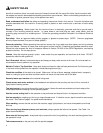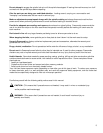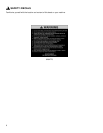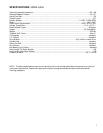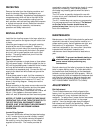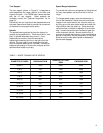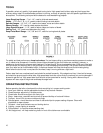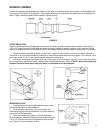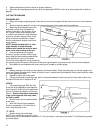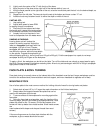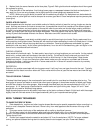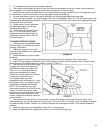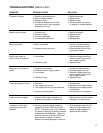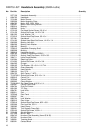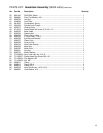
12
4. Rotate workpiece by hand to check for proper clearance.
5. Start lathe at lowest speed and bring it up to the appropriate RPM for the size of stock used (refer to table on
page 9).
CUTTING TECHNIQUES
ROUGHING OUT:
1. Begin with a large roughing gouge. Place the tool on the tool support with the heel of the tool on the surface to
be cut.
2. Slowly and gently raise tool handle until cutting edge comes into contact with the workpiece.
3. Beginning at the tailstock end of the
workpiece, roll the flute (hollowed-out
portion) of the tool in the direction of the
cut, Figure 6. Make long sweeping cuts
in a continuous motion to rough the piece
down to a cylinder. Keep as much of the
bevel of the tool as possible in contact
with the workpiece to ensure control and
avoid catches.
NOTE: Always cut down-hill, or from
large diameter to small diameter.
Always work toward the end of a work-
piece, never start cutting at the end.
4. Once the workpiece is roughed
down to a cylinder, smooth it with a large
skew. Keep the skew handle perpendicular
to the spindle and use only the center
third of the cutting edge for a long smoothing
cut (touching one of the points of the skew to the spinning workpiece may cause a catch and ruin the workpiece).
6. Add details to the workpiece with skew, parting tool, scraper or spindle gouge.
BEADS:
1. Make a parting cut for what is to be a bead to the desired depth. Place the parting tool on the tool support and
move tool forward to make the full bevel of the tool come in contact with the workpiece. Gently raise handle to make
cut to the appropriate depth.
2. Repeat for other side of the bead.
3. Using a small skew or spindle gouge, start in the center between the two cuts and cut down each side to form
the bead. Roll the tool in direction of cut.
COVES:
1. Use a spindle gouge. With the flute
of the tool at 90 degrees to the workpiece,
touch the point of the tool to the workpiece
and roll in towards the bottom of the cove,
Figure 7. Stop at the bottom; attempting
to go up the opposite side may cause
the tool to catch.
2. Move the tool over the desired width
of the cove.
3. With the flute facing the opposite
direction, repeat step 1 for other side of
cove. Stop at bottom of cut.
"V" CUTS:
1. Use the long point of the skew.
(NOTE: Do not press the long point of the
skew directly into the workpiece to create the "V"; this will result in a burned or burnished "V" with fibers being rolled
up at both sides.)



